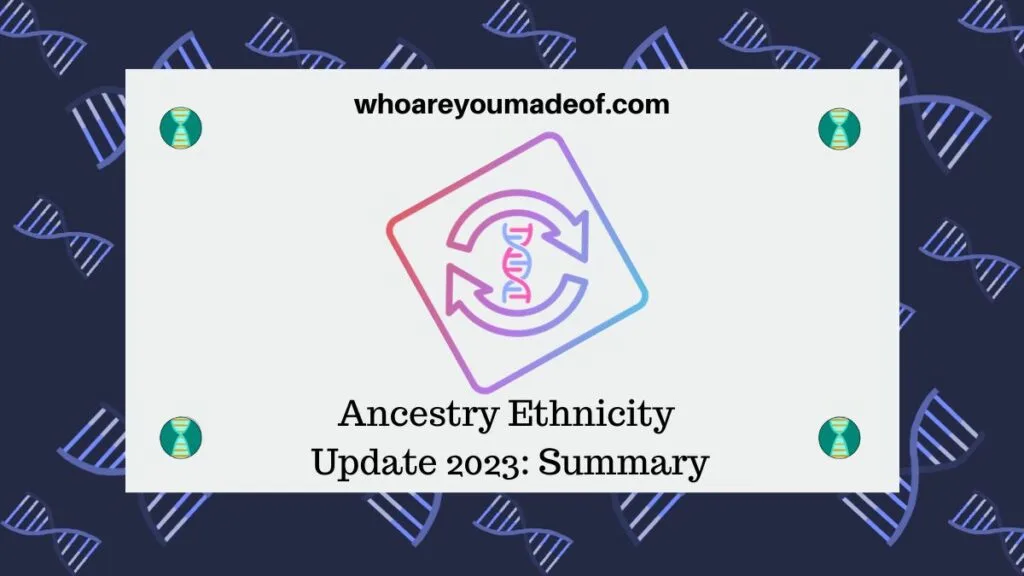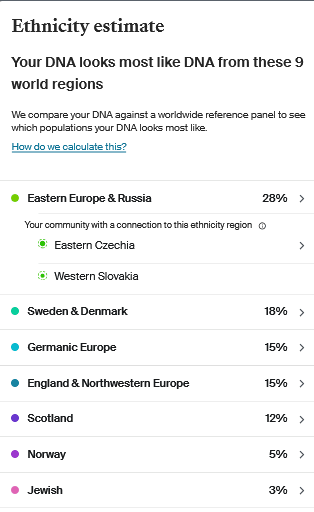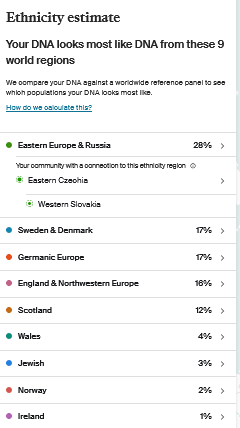Ancestry DNA released the 2023 Ethnicity Estimate update in September. In this post, learn about how this update is different and what to look for on your own updated DNA results.

The fall is always an exciting time for me because it is my favorite season. An extra bonus is that I get to start off the fall with newly-updated Ancestry DNA results each year.
It is important to mention that a different ethnicity estimate does not mean that our actual DNA has changed. Our DNA is the same as it was when we first did our DNA test.
Instead, the technology used to analyze our DNA changes. These changes and improvements mean that our ethnicity estimate is likely more accurate, even though the adjustments can sometimes feel confusing.
Who is affected by the 2023 Ancestry update?
For most Ancestry DNA customers, the 2023 update will result in at least small changes to their ethnicity estimate. Depending on your unique family history, you might see bigger changes in your results with this update.
The 2023 Ancestry update does not affect DNA matches or the family tree side of the Ancestry site. Our DNA matches are updated regularly throughout the year as more people take the Ancestry DNA test.
What are the major changes on the ethnicity estimate for 2023?
The 2023 Ancestry update for ethnicity estimates released in the fall included an updated algorithm and reference panels, in addition to a larger number of DNA samples used to develop the reference panels than were used for past results. We also see several new regions added, and saw two regions "retired".
The newest version of the Ancestry ethnicity estimate was calculated using reference panels based on DNA samples from more than 71,000 people.
With this major fall update and the DNA Communities update that happened earlier this year, our DNA is now compared with more than 2,600 regions, sub-regions, and DNA Communities from all over the world. This is a large increase over the 1,830 regions that were available as of the 2022 Fall update.
As always, this update doesn't come with any additional cost for anyone who has already tested their DNA with Ancestry. These updates happen periodically, with the biggest change in the ethnicity estimate happening in about September each year.
Which regions were added on Ancestry in 2023?
The new regions added for this update are primarily in Asia, though we do see one region that might show up for some people with ancestors from Eastern European regions. The list of new regions added to Ancestry in 2023 are as follows:
- Maritime Southeast Asia
- Western China
- Western Philippines
- Central and Southern Philippines
- Eastern European Roma
Even if you don't have ancestors from any of the communities or regions from the list above, you likely did have an adjustment made to the percentages on your ethnicity estimate. You may also see regions that were not on the previous version of your results, even if they are not recently added regions.
Were any regions removed with this update?
Both the Southeast Asia and Southern Philippines were "retired" with this update. The Southeast Asia region was split into Mainland Southeast Asia and Maritime Southeast Asia, and the Southern Philippines was divided into Western Philippines and Central Southern Philippines.
While those two larger regions "disappeared", the new regions should provide more detailed results for people with ancestors from the Philipines, Thailand, Cambodia, Malaysia, Indonesia, Singapore, Brunei, and Papua New Guinea. These smaller regions can help those who are researching their ancestors have more precise information about exactly where within the larger region their ancestors likely lived.
What if one of your regions disappeared?
If your DNA most closely matches a new region, you might have seen that old region disappear from your results. Alternatively, we could see some smaller regions disappear due to improved results based on an updated algorithm and reference panel, as well as a larger number of DNA samples.
Many people with Romani ancestry from Europe previously reported seeing regions such as Pakistan, Anatolia & the Caucasus, Greece & Albania, the Balkans, Central Asia-South or Northern India on previous versions of their Ancestry results. Since it is widely believed that the Romani people have ancient ancestry from the Indian subcontinent, these regions seemed to make sense.
However, since Ancestry is now able to isolate the Eastern European Roma region on results, those with ancestors who were a member of this community may have seen a south or central Asian region disappear. In the case of those individuals with Romani ancestry, it may have been replaced with the Roma region.
If you saw a region disappear from your results, it means that Ancestry was further able to refine your results to provide greater accuracy. I would suggest making a careful comparison between your new and old results to see which percentages were adjusted and which regions were replaced or removed on your individual results.
What does it mean if your results didn't change much after the update?
If you have done a thorough analysis of your Ancestry results and don't see any big changes in your results, it doesn't mean that your results will never change. As the science behind DNA testing continues to improve, everyone will see more accurate results over time.
Example of updated Ancestry DNA results for 2023
As one example of how Ancestry DNA results could have changed with this update, I have posted my own results below. The first image is of my results prior to the update and the second image is after the update.


To summarize my changes:
- Eastern Europe & Russia - stayed the same at 28%
- Sweden & Denmark - reduced by 1%
- Germanic Europe - increased by 1%
- England & Northwestern Europe - increased by 1%
- Scotland - stayed the same
- Norway - reduced by 3%
- Jewish - stayed the same
My DNA results are a good example of results that did not change drastically with this update. While I did lose a few percentages on some of the ethnicity regions, I didn't lose any of those regions.
This is significant to me because I like to think that the Ancestry results are refined enough for most people at this point that we can feel pretty confident that our ancestors lived in the parts of the world that we see on our results at some point in time.
My most significant change was Norway, which decreased by 3%. The other regions that I saw decrease also correspond with parts of the world where I have no known family tree connection, yet likely do have ancestry from several centuries ago.
And that means that we can get started on our research. The reason that I am interested in DNA testing is because it can be very useful for building my family tree and learning more about where my ancestors lived, and I like to think that our Ancestry ethnicity estimate can provide some clues to help.
How to know if your results have been updated?
For this most recent update, we can be sure that our results are updated as of September 2023. All updated results were published at the end of September, 2023.
If your results say that they are updated as of July or August 2023, this is likely when they were processed for the update. The updated results were only recently accessible to users as of late September, 2023.
Conclusion
I hope that this post has helped you learn more about the changes that have come with this update and how they

Cathleen
Thursday 23rd of November 2023
My father’s ancestors were German for all 7 generations I have traced, and my mother’s were German for the 4 I have found, yet my Ancestry Ethnicity doesn’t even list Germany. How can this be? Thank you.
amare
Tuesday 7th of November 2023
whats my nashinalate
Peter B. Golden
Sunday 1st of October 2023
National Geographic had me as 55% Mediterranean, 21% Southwest Asian, 19% Eastern European and 2% Northeast Asian - as well as 1.4% Denisovan and 1,1% Neanderthal.
Ancestry initially had me as 72% Ashkenazi Jewish, 22% Eastern European, 8% Persian/Turkish/Caucasus, then moved me to 88% Ashkenazi Jewish and a mix of other ethnicities and finally decided that I was %100 Ashkenazi.
Living DNA has me at 50% Europe (subdivided into 39.5% South Italy, Cyprus 5.9%, Basque 4.6%//Europe East : 7,9% Baltic), Near East: 32% North Turkey, 6.3% Arabia; 3.2% North Africa - later results were slightly different but not by much.
My Heritage has me at 85.1% Ashkenazi Jewish, 11.8% East European, 1.8% Italian, 1.3% Middle Eastern/revised: 88% Ashkenazi Jewish 8.9% East European 2% Italian
Genomlink: Other European 54%, Northwestern Europe 20%, East European 12%, Asian 5%, Native People of Americas 1%, African 1% Other 14% 1.1% Sephardic/North African
What is one to make of this?